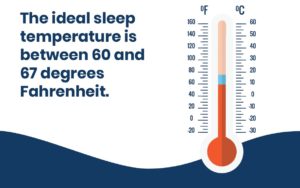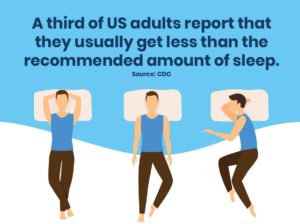Best Temperature for Sleep: What is the Ideal Sleeping Temperature?

The environment we sleep in plays a huge role in how well we sleep each night. If you can remember laying in your bed on a hot summer night, it was likely not a pleasant slumber. That’s because we humans require particular surroundings to get optimal Zzzs.
Best Temperature for Sleep
Tossing and turning at night can happen for several reasons, but one cause you might not think about is the ambient temperature in your bedroom. Of course, we all know what it feels like to overheat during a summer heatwave or wake up with frozen feet outside the blankets during the winter – but even subtle changes in temperature can negatively or positively affect your sleep quality.
Most sleep experts agree that the best temperature for sleep is between 60- and 68 degrees Fahrenheit, or 15.5 – 20 degrees Celsius. But do you know why? Keep reading to learn more about how temperature impacts your sleep, and what you can do to improve your sleep environment.
- How Does Air Temperature Affect Your Sleep?
- What’s the Best Temperature for Sleep?
- Other Sleeping Tips to Keep Your Room Temperature Cool
How Does Room Temperature Affect Sleep?
Before diving into temperature’s effects on your sleep quality, it’s important to understand your body’s underlying mechanism for waking up, feeling sleepy, and feeling hungry: your circadian rhythm. Your body temperature has a 24 rhythm, pushed forward by the biological clock. Your core body temperature is relatively high at daytime, reflecting a high wake drive, and relatively low at night, reflecting a low wake drive.
Because of your body clock, your body cools when you’re ready to go to bed, getting to its lowest levels between 3am and 6am. To cool off your body, your blood vessels widen in your skin. You might notice this at night if your hands and feet feel warm initially – this is just the heat escaping through your skin.
Sleep experts agree that the temperature of your sleep environment impacts how well and how long you sleep. When you’re ready to hit the hay, your core body temperature drops because your brain is trying to get to what’s called a “set point”. If you’re sleeping in an overly warm bedroom, it could block heat loss, making it hard to lower your core body temperature. A very cool temperature might lead to cold hands and feet. To conserve heat, the vessels contract, your skin gets cold, and heat stays in your body.

Both your core temperature and your skin temperature need to be in a certain range. If it goes outside that range, it will cause arousal systems to be activated, which might lead to lighter sleep or even wake.
What’s the Best Room Temperature for Sleeping?
Although the recommended sleeping room temperature range is between 60 and 67 degrees F (15.5-20 degrees C, it’s important to note that the right temperature for you is likely unique. Above all, it’s important to find a temperature that’s comfortable.
If you sleep with a partner, this can be slightly more complicated. Your bed companion may prefer slightly warmer sleep environments, while you may prefer the opposite. Try to find a happy medium temperature so that you’re both comfortable or invest in products to keep yourself warmer or cooler individually.
What’s the Best Temperature for Sleeping By Age?
Although your ideal sleep temperature may shift as you age due to weight and aging changes, the range will still likely fall somewhere in the 60s throughout your life. Women experiencing menopause women might find themselves preferring colder sleep environments, however, to combat heat flashes and other hormonal effects.
Experts recommend setting a thermostat for your baby’s room between 60- and 68 degrees Fahrenheit and 15.5 (20 degrees Celsius) — under the condition they’re properly clothed, of course.
Infants have a harder time regulating their temperature and don’t sleep with covers (because it presents a health hazard). In turn, their smaller, more fragile bodies might need a few more degrees to stay warm overnight.
It’s important to be cautious of your baby overheating, which may increase the risk of sudden infant death syndrome (SIDS). This is more prevalent in the winter than the summer. To check the temperature of your baby by touch, touch the back of their neck or stomach as they sleep. If their skin is sweaty or hot to the touch, it’s a good idea to remove a layer of clothing to help them cool off.

Other Sleeping Tips to Keep Your Bedroom Comfortable
1. Invest in Products to Help You Get Your Best Sleep
Besides controlling the air temperature, there are plenty of other ways to ensure that your sleep is peaceful and restorative. For example, the Sleep Optimizer ChiliPad is a specially-designed mattress pad that has both cooling and heating capabilities. Designed to regulate the surface temperature of the mattress pad, it actively circulates water through microtubes as you sleep. This is an excellent solution if you sleep with a partner who prefers a slightly warmer or cooler sleeping temperature than you.
Comfortable bedding can also dramatically improve your sleep experience. Consider investing in a weighted blanket if you feel like you’re tossing and turning,
or silk pillow covers if you need something extra luxurious next to your skin. If you are on the go be sure to purchase travel pillows or a portable sound machine, as the more comfortable you make your sleep environment, the more likely you’ll get a deeper and more restful slumber.
The more comfortable you make your sleep environment, the more likely you’ll get deeper, more restful slumber.
You can find these products and more at the SleepScore Store.
2. Keep Your Room Temperature Consistent
Maintaining the ideal temperature at night is important. As mentioned earlier, fluctuations can keep you awake or disrupt your sleep. So, set your home’s thermostat to lower during the night when you’re asleep.
You may also want to turn on your AC or turn on the heat if your room temperature falls or rises outside the ideal range. If you have a ceiling fan, you can turn it on to circulate cool air properly.
Don’t have AC? Follow these tips outlined by The Sleep Foundation:
- Prevent heat build-up during the day by keeping the blinds or curtains closed. Open the windows at night if the air is cooler.
- If your bedroom is upstairs but there’s a place to sleep downstairs, consider going down a floor to sleep. Hot air rises, so your lower levels are likely to be cooler.
- Drink water before you go to bed to help yourself cool off.
- Wear light pajamas.
- Invest in an air purifier or fan to circulate air as you sleep.
3. Switch Out Your Bedding Seasonally
If you’re in a more temperate climate, this tip may not be as helpful for you. However, if you live in an area prone to more extreme temperature changes in the form of hot summers and snowy, cold winters, it’s a good idea to switch out your bedding each season.
A down comforter might keep you warm and cozy during the winter, but it’ll be stuffy and uncomfortable when warmer weather arrives. Consider using a lightweight blanket or a comforter made from cooling materials during those warmer months. And if you’re cold underneath a comforter? Add a blanket on top to help insulate your body warmth and follow our tips for staying warm on a cold night.
4. Keep Your Room Dark
If your room is the right temperature but it’s full of light pollution from outside street lamps, or your own digital devices are creating it, you’ll likely still have a hard time falling asleep. It’s important to eliminate those sources of illumination. So, invest in blackout shades, a sleep mask, or purchase light-blocking stickers to place over status lights and power lights for the electronic devices permanently in your room.
5. Create a Sleep-Inducing Routine
Scrolling on your phone for hours is a mindless activity that’s soothing for some. The blue light from your electronic devices may interfere with your body’s ability to produce melatonin, the hormone that your body sends out to signal bedtime.
Add a blue light screen protector or power down your phone and other blue-light devices at least two hours before bedtime.
Instead of using your phone, consider reading a book or trying meditation.
Conclusion: Sleep Cool and Comfortable
Being too hot or cold at night is an uncomfortable experience. A poorly regulated temperature can lead to sleep disruption and overall poor quality of sleep. It’s important to take steps to make sure your bedroom stays at an ideal sleeping temperature as you doze off each night.
And, if you find yourself struggling to fall asleep or stay asleep, it’s a good idea to first check your thermostat before turning to other solutions. It’s usually an easy fix that can dramatically improve your sleep. With these tips, you’ll be able to sleep better, sleep longer, and wake up feeling more refreshed.